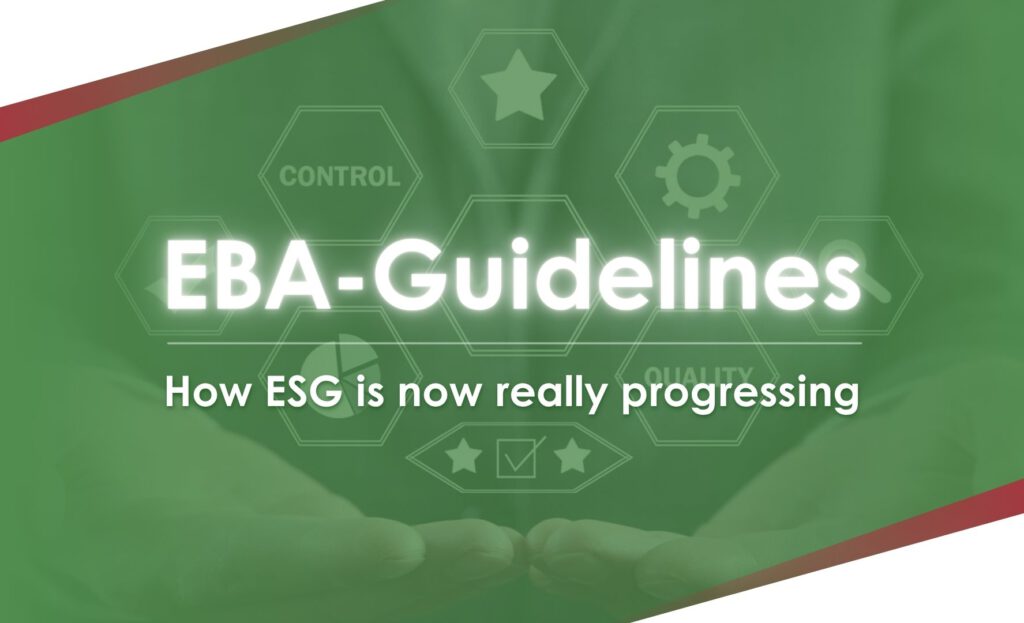Many companies and financial service providers are breathing a sigh of relief: The EU has announced that it will simplify some ESG reporting obligations with the so-called omnibus procedure. Fewer forms, less bureaucracy – sounds like a relief at first.
But beware: the situation is very different for banks and their business customers.
While some are talking about fewer reporting obligations, the European Banking Authority (EBA) has defined clear requirements with the new EBA guidelines – and these are quite something. They stipulate how banks must specifically measure and manage ESG risks and incorporate them into their business strategy from 2026. And companies will also be directly affected by this – especially if they want to obtain financing.
In short: the ESG journey is not slowing down – it is now really picking up speed.
And those who are prepared today will gain a real head start tomorrow.
Why companies need to do the same
Companies will be more in the focus of banks in future:
In order to keep their own ESG risks under control, financial institutions need to know how sustainable and resilient their customers are. This means:
- In future, banks will specifically request ESG data from companies
- Without valid key figures, it will be more difficult and more expensive to obtain loans or investments
- Companies without a clear transformation plan run the risk of falling behind when it comes to financing
💡 The good news: Those who take a strategic approach to ESG improve their chances – with financing, investors and customers.
Ready for the ESG finance check? – 5 questions that companies should have an answer to
If you want to obtain financing or investments in the future, you have to show how your own business model deals with ESG risks. Banks do not ask ESG theory questions – they want clear, comprehensible answers, e.g. to:
- Do you know your most important ESG risks – e.g. in the supply chain or due to rising CO₂ costs?
- Does the company have specific sustainability targets – and who is responsible for them?
- Do you have an overview of your CO₂ emissions – including those of suppliers?
- How do you ensure that ESG aspects are taken into account in investments or new projects?
- Is there a plan for how your company intends to meet ESG requirements over the next 5-10 years?
Such questions increasingly determine your financing – and how your company is perceived in the market.
A framework for practice: ESG READY
Many companies and banks are currently asking themselves: “How can I manage ESG risks in such a way that they are not only controllable – but can also be used strategically?”
This is exactly where our approach comes in. With ESG READY, we offer a practical framework that helps to strategically manage sustainability risks and meet regulatory requirements in a structured manner.
The model is based on five central fields of action: Relevance, Exposure (risk), Activities, Data and Impact. It is important to note that these fields of action are not to be understood as a rigid sequence, but rather as integrated areas of responsibility that are processed simultaneously or with varying intensity depending on the initial situation.
ESG READY stands for:
- R – Recognize relevance: Which ESG issues are critical to my business model?
- E – Assess exposure (risks): How exposed am I to ESG risks – directly or via my partners?
- A – Plan activities: What measures do I derive from this – with what objectives?
- D – Build up data: What ESG metrics do I need – and how reliable are they?
- Y – Show impact: How do I make ESG performance visible internally and externally?

What the EBA specifically requires – and what this means for you
The EBA guidelines make ESG risks a clearly defined regulatory task – and focus on five levers that specifically affect banks and companies:
1. Integrate ESG risks into all risk types:
Whether credit, market, liquidity or reputational risks – ESG factors such as climate change, biodiversity loss or social conflicts must be systematically taken into account in future.
2. Materiality analyses and scenarios:
Regular assessments of the extent to which an institution (or a client) is exposed to ESG risks will become mandatory. In future, these analyses must be supplemented by robust scenarios – for example on the impact of CO₂ pricing or climate damage.
3. develop transition plans:
Each institution must clearly explain how it is managing its risks in the transition to a low-carbon economy – including clear targets, timelines and measures.
4. anchoring in governance and strategy:
Dealing with ESG risks must not be a parallel process. It must be anchored in the business strategy, the management systems (e.g. ICAAP/ILAAP) and internal responsibility – including management’s duty of supervision.
5. cooperation with customers and stakeholders:
Withdrawing from CO₂-intensive sectors is not the goal. Rather, it is about active transition management – banks should support their customers in the transformation. Companies must be able to provide reliable ESG data and strategies for this.
What will change with the EBA guidelines – an overview
| Before | From 2026 (EBA-compliant) |
| ESG as an image issue | ESG as a risk obligation |
| Isolated ESG data | Integrated ESG data processes |
| No scenarios | Scenarios & stress tests |
| No ESG reference in the ICAAP | ESG as an integral part of capital and liquidity planning |
| ESG without consequences | ESG violations with specific supervisory consequences |
ESG compliance is not an optional extra – but a new basic requirement
The EBA guidelines mark a turning point: ESG is no longer a topic for the future, but a regulatory reality.
For banks, this means
- ESG risks must be measurable, controllable and auditable
- Business models must become sustainable – not only in terms of the balance sheet, but also ecologically
For companies, this means
- Those who cannot provide ESG data lose financing scope
- If you don’t have a transition plan, you lose confidence
With ESG READY, you ensure that you not only live up to this reality – but actively shape it.







